But in most cases, the cause of the pain is plaque formed on the teeth, in which pathogenic bacteria constantly multiply and which can easily cause painful inflammation.
Of course, you can try to remove plaque and, with the help of dental floss and careful oral care.
But even if a person devotes enough time to caring for his teeth, he is not able to defeat plaque on his own. Just look at how the plaque develops:
- in a person's mouth Bacteria, food debris and saliva are constantly interacting, as a result of which a non-mineralized, soft plaque is formed, and it is impossible to clean it from everywhere with an ordinary toothbrush;
- with time soft plaque caking, mineralizes and becomes hard and unpleasant to the touch, which cannot be removed at home;
- tartar develops, captures the entire large surface of the tooth, corroding the enamel, and can cause caries and inflammation, which will have to be treated for a long and painful time.
Professional hygienic cleaning of teeth at dentists allows you to remove plaque completely, leaving only healthy enamel, in addition, it includes procedures that strengthen enamel and prevent the formation of tartar.
The main methods of removing dental plaque, which are used by modern dentists.
Dental cleaning of teeth using this technique is based on the use of the following components:
- regular baking soda;
- a jet of air supplied under pressure;
- water jet.
Combining, these three factors make up a single stream, each of the components of which has a certain effect:
- air ensures the delivery of soda to the place of the problem;
- soda, hitting the plaque under pressure, contributes to its exfoliation from the enamel;
- water washes off the departed pieces and reduces the temperature, which always rises during the procedure due to the friction of soda on plaque.
The procedure allows any degree of neglect and provides opportunities for an individual approach to each patient. By adjusting the strength of the jet, the doctor focuses on:
- tooth enamel thickness which soda served too hard can damage;
- , if you do not take into account which, the patient can be very painful;
- thickness of plaque or calculus- the thicker, the more pressure will be needed.
Dental cleaning with Air flow has the following advantages:
- painless. With the right settings, the impact of the jet is almost imperceptible.
- Safety. It is almost impossible to inflict injuries with water and soda.
- Efficiency. The procedure allows you to get rid of plaque of any degree of neglect.
Air Flow lasts for a maximum of six months (often less, depending on the patient's lifestyle), the whole procedure takes about half an hour.
Contraindications for use this method:
- chronic diseases respiratory tract- for example, bronchial asthma;
- allergy to the components of the cleaning mixture;
- increased sensitivity to mechanical influences on the teeth;
- too thin enamel and its increased abrasion;
- - such as , .
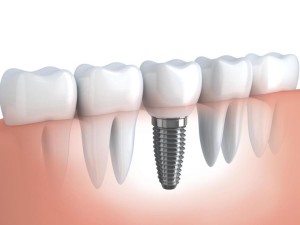
In the photo, the dentition before and after hygienic cleaning using the Air Flow technique
Ultrasonic method
It implies a complex effect with the help of ultrasound, which has the following effect on plaque:
- from the inside destroys all deposits without touching the enamel;
- water or a special solution washes away the remnants of destroyed plaque and creates a feeling of freshness (it is often added aromatic fragrances - menthol, mint, lemon).
The advantages of this method are:
- Safety. Ultrasound is harmless and will not damage the enamel.
- painless. The impact of ultrasound is not felt.
- Flexibility. The nozzle of the apparatus is designed in such a way that it can be brought to the tooth at any angle and clean out even the most inaccessible areas.
- Rapidity. Just one session is enough to get rid of plaque.
The next visit to the dentist after ultrasonic cleaning will be needed in a year (perhaps less, depending on lifestyle).
Contraindications to the procedure are:
- sensitive enamel;
- implants in the patient's body;
- cardiac arrhythmia;
- bronchial asthma and chronic bronchitis;
- SARS;
- hepatitis, HIV, tuberculosis;
- childhood.
Laser correction
Laser teeth cleaning is the most modern method removal of tartar and plaque. The principle of the technique is based on the fact that the laser beam easily evaporates water, and there is several times more water in plaque than in enamel.
Having lost all the water, the plaque begins to peel off in layers, after which the patient is given the opportunity to rinse his mouth and spit.
- High efficiency. The laser quickly removes any plaque, regardless of the degree of its neglect.
- painless. The laser is not felt by the tooth enamel.
- Safety. It is impossible to damage the enamel with a laser.
- Noiselessness. This is a big plus for patients who are intimidated by the sound of the drill and any dental procedures.
- . Of all the procedures, the laser is the best for whitening. tooth enamel.
The procedure has contraindications:
Stages of professional teeth cleaning
Professional hygienic cleaning of teeth is carried out in sequence:
- Soft plaque cleaning. For this, a special small electric brush is used, which is lubricated with professional toothpaste. With its help, they clean off all plaque, which can still be removed using mechanical action.
- Hard plaque cleaning. For this, one of the three methods described above is used (there is also a fourth, in which the doctor manually cleans off solid deposits, but this procedure is currently not in use due to its pain and laboriousness).
- Strips. The tool is a thin metal tape with a rough surface, the thickness of which allows you to insert it into the gap between the teeth and clean the sides of the plaque.
- Polishing. After all cleanings, the teeth remain rough, and if polishing is skipped, plaque will form on them in even greater volumes than before. Small rollers are used for it, which provide the enamel with perfect smoothness.
- Treatment with fluoride varnish. This part of the procedure strengthens the tooth enamel, enriches it with fluoride and prevents the formation of plaque in the future.

The opinion of patients of dental clinics
Incomprehensible nuances can be clarified by studying the reviews of people who have had professional teeth cleaning.
I have always been afraid of dentists almost to the point of hysterics. As a child, my mother could not force me to see a doctor with any persuasion. I recently read on the Internet that professional laser cleaning, firstly, allows you to protect your teeth from diseases, and secondly, it is painless, and thirdly, it is silent. I decided to try.
It turned out - really, not scary. No discomfort, the teeth really seem whiter, and I don’t remember the way to the dentists for a year, because nothing hurts since I started going for cleaning.
I advise everyone!
Lena K
Issue price
Depends on the technique used: 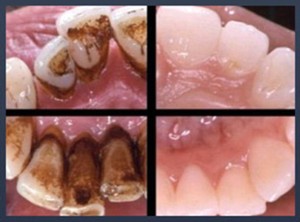
- laser cleaning costs from 3,000;
- Airflow cleaning costs from 1,500 to 3,000, depending on the specific clinic;
- ultrasonic cleaning costs from 1000 to 1500.
professional cleaning needed two or three times a year. It is quick, painless, safe, and at the same time has an inspiring effect on the oral cavity, reducing the risk of dental diseases.
Prevention is always better treatment, and professional oral care is the best preventive measure you can think of.
Even if you take good care of the oral cavity, it is impossible to get rid of the appearance of dental diseases. Therefore, at least 2 times a year, you need to visit the dentist and periodically brush your teeth.
This procedure makes it possible to remove plaque and remove all tartar. Thanks to this, it is possible to achieve a natural whiteness of the teeth. In addition, it is a preventive measure in order to avoid diseases of soft and hard tissues. This process is simple and inexpensive, but together with everything - very effective.
When is a cleaning needed?
It must be said that there are almost no contraindications for this technique, and those that exist can be called relative. You need this service if:
- It is necessary to remove supragingival and subgingival tartar
- Remove plaque
- Measures to prevent exposure to tissue diseases, such as caries and non-carious diseases
- Prevention or treatment of periodontal disease
- To eliminate bad breath
- Prevent periodontal bleeding
- Need whitening to natural color
Basic cleaning methods
It is possible to distinguish hardware and manual methods of influence. If we talk about hardware, then this is Air Flow cleaning, which involves exposure to a strong air flow and abrasive material.
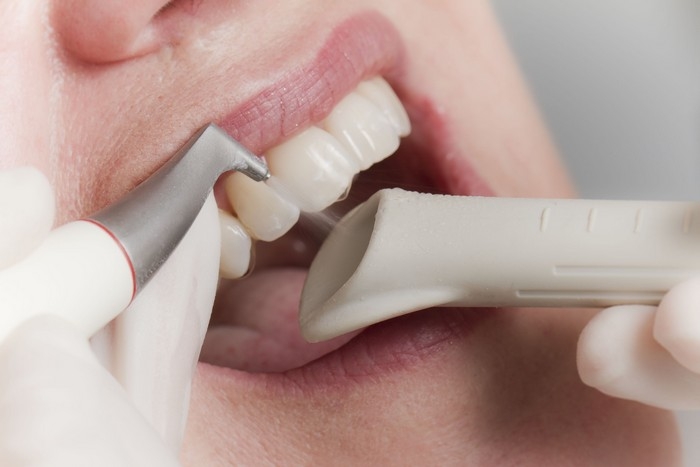
In addition, there is ultrasonic cleaning. This is a process that removes plaque and stones in hard to reach places. A huge advantage of ultrasound is that it has an antibacterial effect on all microorganisms that can live in a person's mouth. But ultrasound can also have some contraindications:
- The patient has a pacemaker
- Diseases of the heart and circulatory system
- Kidney, lung and liver problems
- Demineralized enamel
Laser therapy is the newest of all technologies. The effect is based on the fact that the liquid that is in the stones and plaque evaporates. Due to the fact that it is evaporated by a laser, all deposits are removed layer by layer. The main advantage can be called the fact that with the help of a laser, teeth are also whitened, but among the contraindications can be noted:
- Implants in the body
- Infectious diseases
- Orthopedic design in the mouth
- epilepsy and asthma
If we talk about manual teeth cleaning, then with its help you can:
- Remove pigment and stones in hard-to-reach places
- Smooth surface from plaque
- Remove pigmentation from food
- To prevent the development of pathology in the periodontium
Manual cleaning is carried out with the help of special tools, among which there are strips with an uneven coating, brushes with pastes and curettes. In our clinic, dentists use only professional devices that help patients get rid of stones.
Dental care after brushing
The first day after the procedure, it is better to refrain from eating products that contain dyes. Even at the appointment, our doctor applies an enamel agent to the patient.
After eating, brush your teeth or just rinse with water. But brushing your teeth should be done at least twice a day. To date, there are many pastes that prevent the formation of various deposits. But it is best if the dentist recommends the right one.
According to statistics, every second inhabitant of the Earth remembers as the most unpleasant sensation toothache. Aching and exhausting with periodontal diseases and unbearably sharp with advanced caries, it correctly directs patients to the dentist's office. The only way to make your visits to a specialist more pleasant and rare is to carefully follow hygiene procedures. Only regular cleaning allows you to get rid of plaque, which is an ideal habitat for pathogenic bacteria. To eliminate hard dental deposits and stones that are formed during the reaction of plaque with saliva, it is possible only with the professional help of a dentist.
Professional cleaning - what is it?
Dental cleaning is a thorough removal of soft plaque and calculus, as well as pigments from tooth enamel. The use of cutting-edge tools allows you to quickly and painlessly remove hard formations, without damaging the enamel. As a result, the teeth become 1-2 tones lighter, the gums stop bleeding due to the removal of pressure from them, the condition of the mucous membranes improves in periodontal diseases.
If earlier dental cleaning was reduced to manual removal of tartar and cleaning of hard-to-reach spaces between teeth, then in the arsenal of modern specialists there are less time-consuming, but quite effective methods:
- ultrasonic cleaning;
- laser cleaning;
Each of the procedures perfectly copes with the task of removing tartar and pigment plaque on the enamel, and has a number of its own advantages. The most advanced way is now air cleaning Flow, which is full complex oral care. Other professional methods of brushing your teeth often require additional surface polishing and fluoridation for the longest possible preservation of the result.
Timely removal of hard dental deposits reliably protects against the development of caries and periodontal diseases, which is important for both children and adults. Cleaning your teeth at the dentist is a necessary preventive measure, this procedure should be done at least twice a year.
Ultrasound in dentistry
Ultrasonic cleaning is the oldest of the above methods. Its action is based on the ability of ultrasonic waves of a certain frequency and amplitude of oscillations to painlessly separate hard tartar from enamel without causing damage to it. In addition to hard deposits, the ultrasonic scaler cleans the tooth enamel from soft plaque and pigmentation, so that the enamel restores its natural shade. 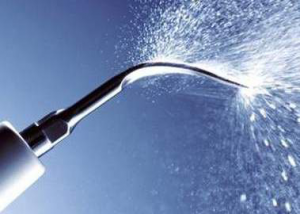
Experienced experts say that ultrasonic teeth cleaning must precede all therapeutic manipulations, from caries treatment to periodontal curettage. The absence of stones and plaque contributes to the healing of the gums and the elimination of their bleeding, improves the quality of adhesion of the filling material to the dentin.
The procedure of ultrasonic cleaning of the teeth, although it does not damage the enamel, does not make it possible to achieve its smoothness, so many specialists resort to additional polishing, and to prevent caries - to sealing fissures, fluoridation. Enamel polishing is considered necessary for the longest retention of the effect - plaque is held worse on a smooth surface.
Ultrasonic cleaning does not injure tooth enamel and does not cause pain to the patient. A rare exception are people whose teeth have hypersensitivity.
Contraindications to the use of ultrasound are:
- the presence of implants and orthopedic structures;
- asthma and chronic bronchitis;
- arrhythmia;
- SARS;
- hepatitis;
- tuberculosis.
Ultrasonic cleaning is not applicable in children's and adolescence- in the presence of dairy or recently erupted permanent teeth. The best option in this case, it becomes manual removal of hard and soft deposits.
Laser cleaning
The action of a laser beam largely depends on the power and intensity of exposure, due to which it has received the widest application in all areas of medicine. The principle of laser teeth cleaning is based on the use of long wavelengths - they have anti-inflammatory and wound-healing effects, and are detrimental to microflora. At the same time, the laser beam is sensitive to changes in density: plaque and tartar, which have lower indicators, evaporate, but there is no negative effect on the enamel. 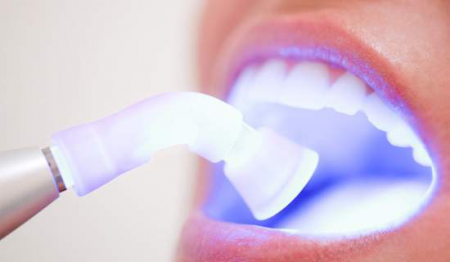
Moreover, the laser stimulates the processes of gum regeneration and increases the permeability of enamel for fluorine, calcium and other nutrients. It is this method of dental cleaning recommended for use in patients with increased sensitivity of teeth, gingivitis and periodontal disease. After cleaning the teeth with a laser, it is recommended to carry out procedures that help strengthen them, such as mineralization and fluoridation.
The laser beam successfully copes not only with hard and soft deposits, but also eliminates pigmentation caused by smoking and taking coloring food and drinks. Thanks to this, the visual effect of whitening is achieved.
The Air Flow technique is an innovative solution that allows you to get rid of stones not only in natural teeth, but also in all types of prostheses - crowns, implants, veneers. It is based on the use of the smallest powder drinking soda, salt and flavor, which are supplied under the pressure of the air flow. The smallest particles delicately polish the enamel, remove soft plaque, hard deposits and dark spots without causing any damaging effect. 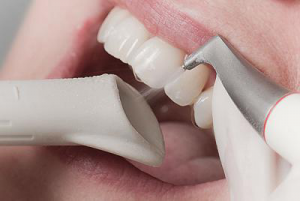
Despite the novelty and popularity of the technique, it has a number of disadvantages, one of which is its high cost. There are a number of contraindications that seriously limit the possibilities of application:
- intolerance to citrus aroma;
- gingivitis and periodontal disease;
- increased sensitivity of teeth and thinness of enamel;
- asthma and chronic bronchitis.
Often procedure Air Flow is called whitening, which is associated with a high efficiency in removing pigmentation and increasing the transparency of enamel.
How much does cleaning cost?
When considering all possible methods The most weighty argument for most people is the price of the service. Professional cleaning is a procedure, the cost of which varies widely, depending on the clinic and additional procedures - polishing, fluoridation, and others. Meanwhile, the prices for the new Air Flow method are significantly higher than for the usual ultrasonic cleaning procedure.
Any person must necessarily monitor the oral cavity in order to avoid increased bacterial activity, destruction of dentin. Dental cleaning is becoming more and more in demand every year, as many patients have already received a snow-white smile, an updated dentition.
What is professional teeth cleaning
The progressive procedure is carried out in dental office with the help of special tools in order to remove the stone and plaque, provide a whitening effect, reliable protection from caries. There are a number of ways to achieve the desired result, but in practice, mechanical and ultrasonic methods are more often used. The first is more traumatic, while ultrasound provides safe hygienic brushing of teeth without pain or fear.
Indications and contraindications
Comprehensive teeth cleaning is a hygienic procedure available to everyone. Before conducting it, a specialist in the clinic checks the presence of medical indications and contraindications. Appoint a session if you want to whiten the enamel by 2-3 tones, as well as in the case of stone disease, after prolonged wearing of braces, in the presence of a disgusting plaque due to malnutrition, bad habits. A few hygienic sessions are quite enough to finally get rid of problems with dental health, eliminate cosmetic defect.
There are also contraindications that significantly limit the list of patients for hygienic cleaning of teeth. It:
- progressive pregnancy;
- respiratory pathologies of the acute stage;
- myocardial problems;
- hypersensitivity or erosion of enamel;
- inflammatory processes gums
How much does a dental cleaning cost
Before agreeing to the procedure, it is important to find out its cost. Only cleaning with a classic brush at home is available for free, and you have to pay extra for a professional session. As you know, carrying out one hygienic procedure is not at all enough to achieve the desired result; it is imperative to complete a full course, consisting of 7-10 scheduled cleanings. Prices vary, but the approximate rates in the province can be found in detail below:
- Teeth cleaning with ultrasound, depending on the chosen technique - from 500 to 2,000 rubles per item.
- Mechanical bleaching method - from 100 rubles per unit.
- Laser teeth cleaning - from 3,500 rubles (with participation in the action it always comes out much cheaper).
Teeth brushing methods
If during a preventive examination the dentist says that hygienic cleaning of the teeth is simply necessary, you should not refuse to carry out the proposed procedure. You have to spend time and money, but the desired result will please you and last a long time. It is important to find out more about the types and prices, follow medical recommendations, and rely on your financial capabilities.
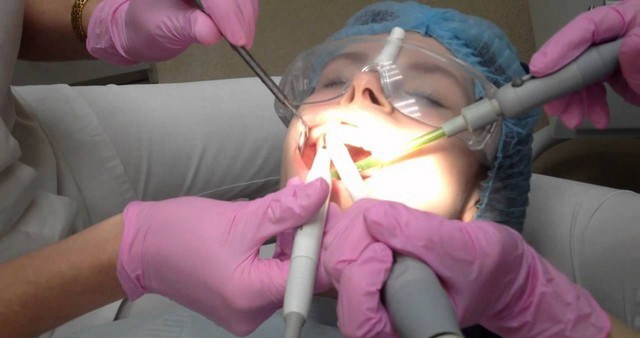
Ultrasonic
During the procedure, doctors use a dental scaler, the vibration of which successfully removes tartar. In this way, you can get rid of old enamel deposits, restore the whiteness of your smile. To reduce the intensity of unpleasant deposits, a water pressure is applied, which has a cooling effect. The procedure feels painless, but in some clinical pictures doctors use local anesthesia.
Laser teeth cleaning
The basis of the method is the effect of a laser beam on a liquid, since, in fact, all harmful formations on the surface of the enamel have a water structure like a sponge. Such a tool ensures the rapid destruction and removal of plaque and stones, while not injuring the structure of the entire row. The effect obtained lasts for six months or more, but it is required to carefully observe all the conditions of the session.
In such a progressive way affordable price you can strengthen the gums and enamel, get a lasting result in as soon as possible. There are no disadvantages of this hygienic method, and laser teeth cleaning is carried out in one stage without pain and discomfort. Among the negative points, it is worth emphasizing: the session cannot be performed on a child, the age limit is up to 18 years.
Sandblasting
The effectiveness and benefits of such hygienic cleaning of teeth lies in the real ability to quickly remove all dense deposits on enamel, stone. The procedure must be carried out 1 time in six months as a mandatory professional hygiene. The essence of the method is that with the help of a medical instrument, a powder with water under high pressure, which just provides a thorough cleaning, clarification by 3-4 tones.
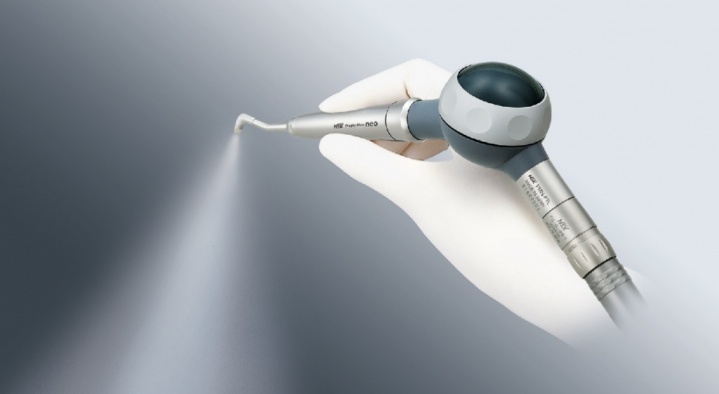
Mechanical teeth cleaning
This is one of the very first methods of hygienic cleaning, which has a number of disadvantages. For sensitive enamel is contraindicated, injures the dentition. At mechanical action even obsolete plaque can be removed, whiteness can be ensured, but in order to preserve the effect, the patient will have to completely abandon bad habits, control nutrition for coloring ingredients.
How to brush your teeth in dentistry
The procedure includes four stages, each of which replaces the next one in one session at the dentist. This makes the teeth not only snow-white, but also strong, healthy, and provide reliable prevention of caries at any age. In the absence of contraindications, the sequence of actions of the dentist is as follows:
- First of all, plaque and stones are painlessly removed by ultrasound. The scaler quickly splits all hard deposits, superficially cleans tooth enamel. At this stage discomfort and there is no discomfort, brushing your teeth with ultrasound is not scary, even pleasant.
- At the second stage, the doctor uses the innovative Air-flow technique, which provides high-quality cleaning of hard-to-reach places in the dentition. A special substance is applied to the surface of the enamel, which fills all the cracks, followed by the destruction of bacteria and hard deposits. The procedure is also painless, but it takes a certain time, the patient's perseverance.
- Then polishing takes place to prolong and fix the resulting aesthetic effect. With the help of a special abrasive paste, the doctor ensures the gloss and whiteness of the enamel, protects it from the action of pathogenic microbes, and eliminates the risk of carious cavities.
- The final step in hygienic cleaning is the application of a special film impregnated with fluorine. This is an additional protection of the teeth, several times increasing the natural stability of the dentition. The absence of one of the declared stages reduces the final effectiveness of this expensive hygienic session.

Preventive teeth cleaning at home
After the hygiene procedure in a hospital, the doctor gives the patient valuable recommendations. It is important to brush your teeth daily with the prescribed toothbrush and toothpaste, to avoid the consumption of coloring foods and the presence of bad habits. It is advisable to perform the obligatory hygienic procedure twice a day - in the morning and before going to bed, and after that do not eat any food until the morning awakening.
Video: professional oral hygiene
For the health of the gums and teeth, it is important to regularly remove hard deposits, they can provoke periodontitis. In modern dentistry, there are several cleaning methods. Which method to use is chosen by the attending physician after examining the patient.
Causes
Many microorganisms live on the surface of the teeth and form bacterial plaque. At the base of the crowns, they accumulate the most. If it is not removed, then gradually it turns into hard plaques, and then into tartar.
Causes of plaque formation:
- Hygiene products are chosen incorrectly.
- The diet is low in solid foods.
- Teeth are brushed incorrectly.
- Oral hygiene is poor.
- Chewing food is done with one side of the teeth.
- Metabolism is disturbed in the body.
Hard deposits can occur on any teeth, but are most susceptible to them inner side lower incisors. Tartar can provoke gum replenishment, periodontitis, gingivitis, bleeding.
You can't get rid of tartar on your own. And the use of funds traditional medicine can only do more harm.
Removal methods
After inspection oral cavity the dentist will offer the best options for removing tartar. Depending on the method and number of teeth, the procedure can take quite a long time. New methods do not provide negative impact on tooth enamel.
Air flow
 With this method small deposits are removed. The procedure is performed by a special apparatus that supplies sodium bicarbonate, water and air, under high pressure. This method does not injure the enamel, and is also absolutely painless. Air Flow is well suited for removing stains from tea, cigarettes, coffee.
With this method small deposits are removed. The procedure is performed by a special apparatus that supplies sodium bicarbonate, water and air, under high pressure. This method does not injure the enamel, and is also absolutely painless. Air Flow is well suited for removing stains from tea, cigarettes, coffee.
This method cannot be used when bronchial asthma and inflammation of the gums. The system cannot remove large deposits of tartar.
Laser cleaning
The method effectively removes tartar and whitens the enamel. Mineral deposits are affected by a laser beam that destroys harmful microorganisms and dense coating. The procedure contributes to the normalization of mineral metabolism and blood circulation. Laser removal of tartar is absolutely painless, and the result is visible immediately after the session.
The procedure cannot be carried out:
- At in large numbers fillings and extended teeth.
- The presence of endoprostheses.
- Increased sensitivity of the oral cavity.
The price for procedures is determined by the session, and not by the number of teeth.
ultrasonic cleaning
This is the most effective method removal of tartar. The main advantage of ultrasound is that it allows get rid of all kinds of dental deposits:
- Pigment plaque.
- Subgingival stone.
- Soft plaque.
- supragingival stone.
On the Internet there are negative reviews about ultrasound. This is due to the fact that some doctors remove only the supragingival calculus, and do not touch the subgingival, this leads to tooth mobility. The minimum procedure time is 1 hour. This is enough to remove pigment plaque or supragingival calculus. In simple cases, the procedure can be performed by a dentist-therapist. But if the patient suffers from periodontitis, then it is best to consult a periodontist for cleaning. This will ensure that the subgingival calculus is removed.
The procedure consists of 3 steps:
- Polishing.
- Fluorination.
The first stage of the procedure is performed using a special apparatus, which is called a scaler. It can be made as a separate unit or built into the dental chair. The main detail in the device is a special metal head. The tip of this nozzle oscillates at a high frequency. During operation, water is supplied to the head, which is removed by a saliva ejector.
The removal of excess from the surface of the teeth occurs due to the oscillation of the nozzle, from which they are destroyed, and the water washes away the remnants. For an effective procedure, the doctor must have sufficient experience. Water is used not only to clean the surface of the tooth, but also for cooling.
Benefits of ultrasonic scaling:

Disadvantages of ultrasonic scaling:
- Older generation machines used nozzles with a circular motion, which gives a very big chance damage to the surface of the tooth.
- High qualification of the doctor - the device is exacting to professionalism of the personnel. With proper skill, 1 hour is enough to clean all the teeth, but in some patients it is also necessary to remove subgingival stones, which are usually invisible during visual examination. Finding and removing such deposits is a painstaking process that requires high skill and several procedures.
Polishing is a very important step that is carried out after ultrasonic cleaning. During this process, small particles of stone and plaque are removed.
Polishing is carried out in two ways:
- With the help of a brush and polishing paste, the entire surface of the teeth is affected.
- Using Air Flow - Using this method, a mirror shine is achieved.
Fluorination is optional, but a very desirable stage of ultrasonic cleaning. Immediately after the procedure, the teeth get the maximum effect from the use of this substance. Fluoridation can significantly reduce the sensitivity that is sometimes seen when more tartar is removed. The impact is made using special gels with high content substances. In a good clinic immediately included in the price.